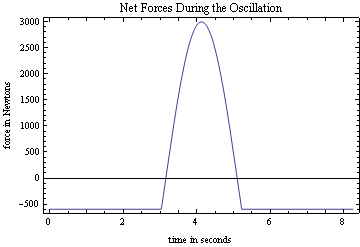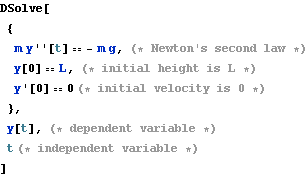
Bungee Jump
In this worksheet we use Mathematica to solve all equations analytically, straight from Newton's 2nd Law. This is a unidirectional motion problem which may give you ideas for ways to solve (analytically or numerically) other unidirectional motion problems (just change the forces), and perhaps even some multidirectional motion problems as well. P. Fraundorf © 2 Oct 2008
First leg of the drop
Below we use Newton's 2nd Law to equate mass time acceleration to the sum of forces, and then set the initial height to rope length L and initial velocity to zero.

Out[38]=
![]()
The result is of course the equation for constant acceleration for a drop from height L. Therefore for the first leg we can define:
In[20]:=
![]()
We can solve this for t when yfinal is zero:
In[21]:=
![]()
Out[21]=
![]()
In[22]:=
![]()
Using the HRW example values of L=45 metres; m=61 kg; g = 9.8 ![]() ; and k = 160 N/m, this gives a
time elapsed during the first leg of:
; and k = 160 N/m, this gives a
time elapsed during the first leg of:
In[23]:=
![]()
Out[23]=
![]()
We can also solve for the velocity as a function of time :
In[19]:=
![]()
Out[19]=
![]()
This is another of the standard equations of constant acceleration :
In[25]:=
![]()
From this we can solve for the velocity at the end of that first leg :
In[2]:=
![]()
![]()
![]()
In[34]:=
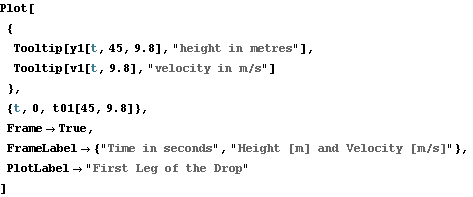
Out[34]=
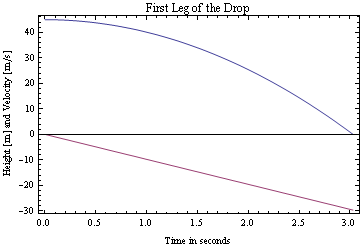
Second leg of the drop
When the spring force kicks is at y = 0, the new sum of forces looks like ...
In[56]:=
![]()
In[57]:=
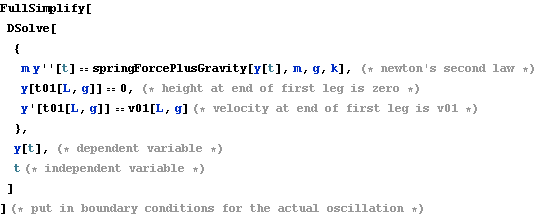
Out[57]=

Note: The above result was messier for first pass, because I' m cautious about using Simplify for FullSimplify as they often hang up. In this case, I managed to clean up want was a sprawling mess by feeding the output of the DSolve routine into the FullSimplify command.
Hence for the 2nd leg, the height as a function of time is ...
In[46]:=

The above equation describes a sinusoidal oscillation of angular frequency ![]() about the point y = -g
about the point y = -g![]() where the gravity force and the spring force exactly cancel one another out.
where the gravity force and the spring force exactly cancel one another out.
To determine how long the second leg of the jump lasts, we solve for times at which y comes back up to zero ...
In[47]:=
![]()
![]()
Out[47]=

Choosing the solution that occurs after t01 we get ...

![]()
Out[48]=
![]()
Solving for the velocity during the second leg, we get ...
In[50]:=
![]()
Out[50]=

In[51]:=

In[55]:=
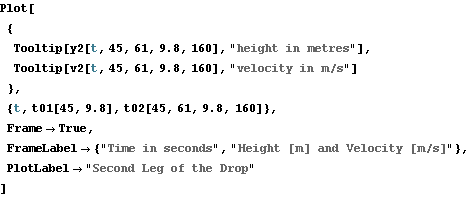
Out[55]=
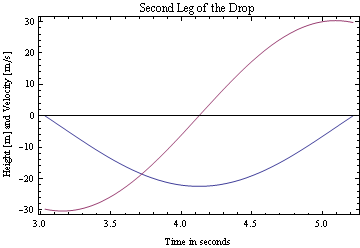
Third leg of the jump
In[63]:=
![]()
In[64]:=
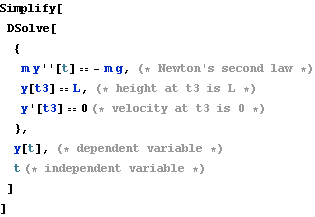
Out[64]=
![]()
In[65]:=
![]()
In[68]:=
![]()
Out[68]=
![]()
In[70]:=
![]()
Full Oscillation
In[71]:=
![]()
In[74]:=
![]()
In[76]:=
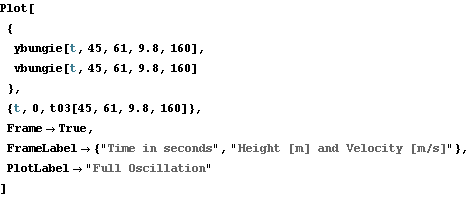
Out[76]=
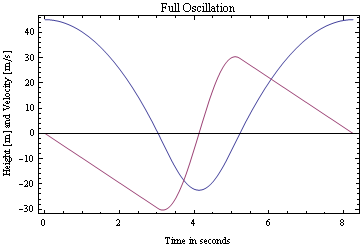
Force Analysis
In[94]:=
![]()
In[95]:=
![]()
Out[95]=
![]()
In[96]:=
![]()
Out[96]=
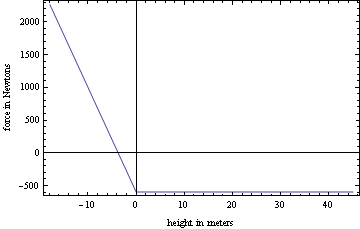
In[97]:=
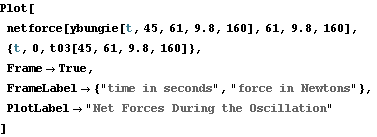
Out[97]=
